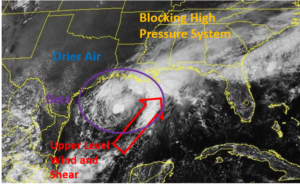Hurricane Sam passed east of Bermuda on Saturday morning. At 11:00 a.m. EDT on Saturday the center of Hurricane Sam was located at latitude 33.9°N and longitude 59.3°W which put it about 335 miles (540 km) east-northeast of Bermuda. Sam was moving toward the northeast at 17 m.p.h. (28 km/h). The maximum sustained wind speed was 130 m.p.h. (210 km/h) and there were wind gusts to 155 m.p.h. (250 km/h). The minimum surface pressure was 945 mb.
Hurricane Sam was still a powerful hurricane when it passed east of Bermuda on Saturday morning. Sam was rated at Category 4 on the Saffir-Simpson Scale. A circular eye with a diameter of 30 miles (50 km) was present at the center of Hurricane Sam. The eye was surrounded by a ring of strong thunderstorms and the strongest winds were occurring in that ring of storms. Bands of showers and thunderstorms were revolving round the core of Sam’s circulation. Storms near the core generated strong upper level divergence that pumped mass away to the north of the hurricane.
The size of the circulation around Hurricane Sam continued to increase in size as it moved farther to the north. Winds to hurricane force extended out 65 miles (10 km) from the center of Sam. Winds to tropical storm force extended out 240 miles (390 km) from the center of circulation. The Hurricane Intensity Index (HII) for Hurricane Sam was 25.1. The Hurricane Size Index (HSI) was 20.6 and the Hurricane Wind Intensity Size Index (HWISI) was 45.7.
Hurricane Sam will move through an environment capable of maintaining a major hurricane during the next 12 hours. Sam will move over water where the Sea Surface Temperatures are near 27˚C. It will move through a region where the upper level winds are weak during the next 12 hours. An upper level trough east of the U.S. will produce southwesterly winds that will start to affect Hurricane Sam on Sunday. Those winds will blow toward the top of Sam’s circulation and they will cause more vertical wind shear. Hurricane Sam will also move over cooler water on Sunday. The wind shear and cooler water will cause Hurricane Sam to weaken as it begins a transition to a strong extratropical cyclone.
The upper level trough east of the U.S. will steer Hurricane Sam toward the northeast later during the next several days. On its anticipated track Hurricane Sam will pass southeast of Newfoundland on Monday. Sam could be a powerful extratropical cyclone southeast of Greenland by early next week.
Elsewhere over the Atlantic Ocean, Tropical Storm Victor weakened west of the Cabo Verde Islands. At 11:00 a.m. EDT on Saturday the center of Tropical Storm Victor was located at latitude 13.1°N and longitude 37.2°W which put it about 905 miles (1455 km) west of the Cabo Verde Islands. Victor was moving toward the northwest at 12 m.p.h. (19 km/h). The maximum sustained wind speed was 40 m.p.h. (65 km/h) and there were wind gusts to 50 m.p.h. (80 km/h). The minimum surface pressure was 1005 mb.

